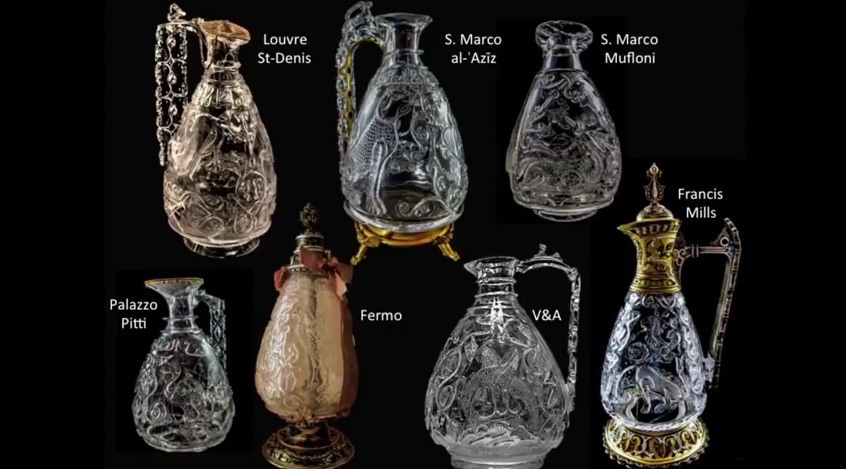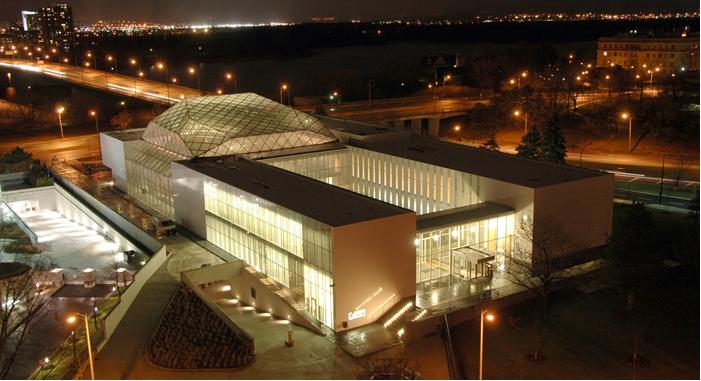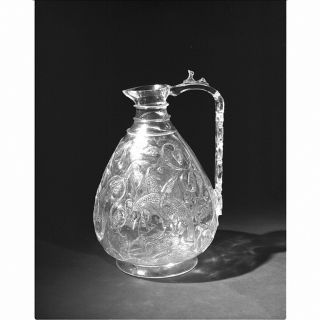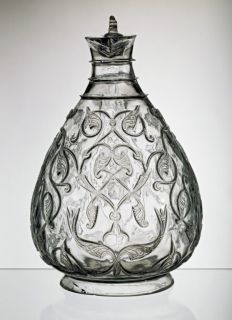Introduced by MALIK MERCHANT
(Publisher/Editor Simerg)

In 2008, the same year that the Delegation of the Ismaili Imamat Building was opened by Canada’s Prime Minister Harper in the presence of Mawlana Hazar Imam, His Highness the Aga Khan, a rediscovery of a spectacular medieval Islamic rock crystal ewer, forgotten since the mid-19th century, provided the catalyst for the re-examination of all of the surviving rock crystal ewers — the “Magnificent Seven”— carved for the Fatimid caliphs of Cairo in about the year 1000.
Jeremy Johns, and his colleague Elise Morero, are on the verge of completing a new multidisciplinary study of the Magnificent Seven and related artefacts, which is intended to be the first phase of a much wider project to examine the medieval Islamic carved rock crystal “industry”.

The Fatimid Imams-Caliphs of Egypt who founded the city of Cairo in 969 and also the Al-Azhar University, are ancestors of His Highness the Aga Khan. They prized the qualities of the rock crystal and carved them into vessels of different forms. In seeking to conceive a design for the Delegation of the Ismaili Imamat Building, His Highness wanted to connect the new building symbolically to the faith of Islam. The suggestion he made to the renowned Japanese architect, Professor Maki, focused on creating a certain mystique, centred around the beautiful mysteries of rock crystal.
In answering, “Why rock crystal?” the 49th Ismaili Imam explained:
“Because of its translucency, its multiple planes, and the fascination of its colours – all of which present themselves differently as light moves around them. The hues of rock crystal are subtle, striking and widely varied – for they can be clear or milky, white, or rose coloured, or smoky, or golden, or black.
“It is because of these qualities that rock crystal seems to be such an appropriate symbol of the profound beauty and the ever-unfolding mystery of Creation itself – and the Creator. As the Holy Qur’an so powerfully affirms, ‘Allah is the Creator and the Master of the heavens and the earth.’ And then it continues: ‘Everything in the heavens and on earth, and everything between them, and everything beneath the soil, belongs to Him’.”
We divide this post into two parts. We begin with an introductory piece on Fatimid ewers by Aliza Moledina, which is followed by a link to an extraordinary video presentation by Jeremy Johns, who with his colleague has used the traditional techniques of stylistic analysis and has returned to the written sources for the production and life histories of the ewers. Both the researchers have also subjected all seven ewers for the first time to detailed archaeometrical and tribological analyses, and have drawn upon ethnographical studies, archaeological excavation, and experimental archaeology to interpret their new findings.
The lecture gives a concise overview of their progress to date, and attempts to replace the ewers back into the socio-economic context from which they were produced. It is copiously illustrated with new images of these extraordinary artefacts, revealing hidden detail that puts us in touch with the hands of the craftsmen that made them.
~~~~~~~~
1. A BRIEF NOTE ON FATIMID ROCK CRYSTAL EWERS

Compiled By ALIZA MOLEDINA
Introduction:
The Fatimid Period in Islamic History (909–1171 C.E.) is characterized by the Imam-Caliphs’ emphasis on the search for knowledge and religious tolerance. Artwork thus gained importance and flourished. The Fatimids were able to draw upon diverse skills and knowledge from many sources to develop new techniques and styles for their artwork.
The Fatimids produced a wide variety of very beautiful and skilfully crafted works of art in textiles, ceramics, woodwork, metalwork, jewellery and rock-crystal. However, only a limited number of examples are available today, and it is by sheer chance that some happen to have a name or signature which links them to the Fatimids. The main reason why our knowledge of Fatimid objets d’art is so limited is that the great Treasury in which the Fatimids stored all their riches was looted between the years 1067 and 1072. They were then sold, melted down and minted into coins to be dispersed amongst the population of Fustat, or carried by merchants to other countries.
Rock Crystal
As a rare medium of art, rock crystal is made of pure quartz crystal and was only shaped by masterful craftsmen which made it highly valued by the Fatimids. The purest crystals were imported from Basra, Yemen and the islands around the East African Coast.

Of all the rock crystal objects manufactured by Fatimid artisans, the Fatimid rock crystal ewers, such as the one shown at the top of this page, are considered among the rarest and most valuable objects in the entire sphere of Islamic art. Only five were known to exist before the extraordinary appearance of an ewer in a provincial British auction in 2008 which was later sold at Christie’s last October. It was the first time one has ever known to have appeared at auction. The last one to surface on the market was purchased by the Victoria and Albert Museum in 1862.
Of the very few rock crystal objects extant today (180 in total), only a few can be securely dated back to the Fatimid period. The treasury of the Basilica of San Marco in Venice has two ewers, one of which bears an inscription to the Fatimid Imam al-Aziz (975-996). Another rock crystal ewer holding an inscription to his son, Imam al-Hakim, is in the Cathedral of Fermo in Italy. An additonal rock crystal ewer was in the treasury of the Abbey of Saint Denis in Paris and is now in the Louvre. The one in the Museum of Limoges in France was stolen in 1980. Disaster also befell the final known ewer which was from the Pitti Palace collection in Florence and had an inscription to Husain ibn Jawhar. It had been on display in the Museo degli Argenti, and it was accidentally dropped by a museum employee in 1998, shattering it irreparably. Finally, a rock crystal crescent in the Museum in Nuremberg, which may have been mounted on a horse’s bridle as a royal emblem, bears the name of the Imam al-Zahir (1021-36).
In addition to the five (and now six) ewers, three or four smaller oval flasks are known to exist including one in the Victoria and Albert Museum in London (located just across from the Ismaili Jamatkhana and Centre), one in the Freer Gallery in Washington DC, and one in the Keir Collection, London. The oval flask in the Freer Gallery has a 17th century gold and enamel setting and is described by the museum as dating from the reign of the Hapsburg Emperor Rudolf II.
“The opulence of the Fatimid court fueled a renaissance in the decorative arts, which made Cairo the most important cultural center in the Islamic world. Nearby, Old Cairo, known as al-Fustat, became a major center for the production of pottery, glass, and metalwork, and rock-crystal, ivory, and wood carving; textile factories run by government officials created tiraz fabrics in the name of the caliph elsewhere in the Egyptian region, especially the Nile Delta. A novel, more refined style developed in pottery; bands with small animals and inscriptions now formed the major decoration in textiles; and rock-crystal carvers demonstrated great skill in works created for and treasured by the caliphs themselves.” — Excerpt from “The Art of the Fatimid Period,” Heilbrunn Timeline of Art History, Metropolitan Museum of Art
The Kitab al-Hadaya wa’l-Tuhaf (The Book of Gifts and Rarities, selections published by Harvard University Press; Cambridge, Mass., 1996) says that when Imam al-Mustansir was forced to open his treasury in 1068, the looters of the Palace “brought out of the Treasury of Precious Objects 36,000 pieces of rock crystal”.

The extant rock crystal objects with no identifying inscription on them appear to be types of containers, either goblets for drinking or ewers and basins for holding liquids, perhaps for washing the hands of the guests after a meal. Over the centuries, many magical properties or benefits were deemed to be associated with objects made using rock crystal.
For example, by simply procuring a vessel made of rock crystal, an individual’s craving for water was considerably reduced. It was said that rock crystal glasses were supposed to shatter on contact with poisoned liquids, or the liquid changed colour, which is perhaps why they were so popular with rulers.
Cups of crystal are also mentioned repeatedly in the Qur’an as one of the many items the Believer has to look forward to in Paradise; for example in Sura 37 (Al-Saffat, The Arrangers, Verses 45-47, tr. Abdullah Yusuf Ali):
“Round will be passed to them a cup from a clear-flowing fountain, crystal-white, of a taste delicious to those who drink (thereof), free from headiness; nor will they suffer intoxication therefrom.”
This Qur’anic reference may suggest another reason why rock crystal drinking vessels were so popular in the Muslim world.

The skill required to hollow out a piece of crystal without blemishing it meant that relief decoration was often kept to a minimum, unlike other media in Islamic art where the surfaces were covered with decoration, to ensure that the viewer could appreciate the craftsmanship of the object. When adorned with relief carving, this usually depicted floral or animal themes, especially lions and birds amongst palmettes. Occasionally gold or precious stones were added on the handle, or to hide a cloud or knot in the crystal; however generally the purity of the crystal was judged sufficient in itself.
_________

About the author: This piece is an expansion of a special Powerpoint presentation made by Aliza Moledina for a special Literary Night event held in Ottawa, Canada, in 2008 to commemorate His Highness the Aga Khan’s Golden Jubilee Celebrations. Aliza was at that time completing her Grade 12 studies at the Colonel By Secondary School, in Ottawa, Canada, after which she proceeded to the University of Western Ontario, in London, Ontario, Canada from where she recently graduated in medicine.
~~~~~~~~
2. ‘THE MAGNIFICENT SEVEN’ A VIDEO PRESENTATION BY JEREMY JOHNS
Date posted: July 30, 2015.
Last updated: August 13, 2021.
____________________

About Jeremy Johns: Professor Johns is Professor of the Art and Archaeology of the Islamic Mediterranean and Director of the Khalili Research Centre (KRC) for the Art and Material Culture of the Middle East in the University of Oxford. He is principally interested in relations between Muslim and Christian societies in the medieval Mediterranean as manifested in material and visual culture. His research has focused upon the archaeology of the transition from late antiquity to early Islam in the Levant and, especially, upon the archaeology, history and art history of Sicily under Islamic and Norman rule, from the Muslims’ conquest of the island in the 9th century to the destruction of the Islamic community of Sicily by Frederick II. His recent and forthcoming publications include the first comprehensive study of the Islamic painted ceilings of the Cappella Palatina in Palermo, and editions and studies of Arabic and bilingual documents from Norman Sicily. Amongst other projects, with Dr Elise Morero (KRC), he is currently engaged on a multidisciplinary study of the medieval Islamic carved rock crystal “industry”.

Excellent: you outdo yourself every time Simerg!
Beautiful collection of rare Fatimid period rock crystal vessels. Thank you Malik.